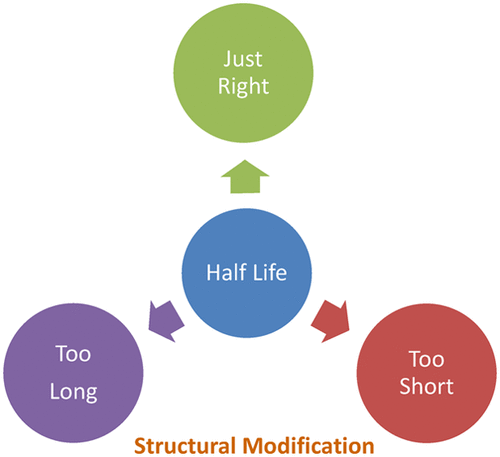当前位置:
X-MOL 学术
›
J. Med. Chem.
›
论文详情
Our official English website, www.x-mol.net, welcomes your feedback! (Note: you will need to create a separate account there.)
Relevance of Half-Life in Drug Design
Journal of Medicinal Chemistry ( IF 7.3 ) Pub Date : 2017-11-17 00:00:00 , DOI: 10.1021/acs.jmedchem.7b00969 Dennis A. Smith , Kevin Beaumont 1 , Tristan S. Maurer 1 , Li Di 2
Journal of Medicinal Chemistry ( IF 7.3 ) Pub Date : 2017-11-17 00:00:00 , DOI: 10.1021/acs.jmedchem.7b00969 Dennis A. Smith , Kevin Beaumont 1 , Tristan S. Maurer 1 , Li Di 2
Affiliation

|
Drug half-life has important implications for dosing regimen and peak-to-trough ratio at the steady state. A half-life of 12–48 h is generally ideal for once daily dosing of oral drugs. If the half-life is too short, it may require more frequent dosing in order to maintain desired exposures and avoid unnecessarily high peak concentrations. This may pose challenges to achieving optimal efficacy, safety, and patient compliance. If the half-life is too long, the time over which accumulation and subsequent elimination occur may be prolonged. This may pose problems with managing adverse effects and the design of efficient clinical trials. Half-life is a key parameter for optimization in research and development. Structural modification to affect clearance, and to a lesser extent volume of distribution, is the preferred means of modulating half-life. An effective approach to half-life optimization requires an understanding of the many pitfalls associated with its estimation and interpretation.
中文翻译:

半衰期在药物设计中的相关性
药物半衰期对稳态下的给药方案和峰谷比具有重要意义。一般每天口服一次口服药物的理想半衰期为12–48小时。如果半衰期太短,则可能需要更频繁地加药,以维持所需的暴露并避免不必要的高峰值浓度。这可能对实现最佳疗效,安全性和患者依从性构成挑战。如果半衰期过长,则可能会延长积累和随后消除的时间。这可能会带来不良影响的管理和有效的临床试验设计方面的问题。半衰期是优化研发的关键参数。影响清除率并在较小程度上分配体积的结构修饰是调节半衰期的首选方法。
更新日期:2017-11-19
中文翻译:

半衰期在药物设计中的相关性
药物半衰期对稳态下的给药方案和峰谷比具有重要意义。一般每天口服一次口服药物的理想半衰期为12–48小时。如果半衰期太短,则可能需要更频繁地加药,以维持所需的暴露并避免不必要的高峰值浓度。这可能对实现最佳疗效,安全性和患者依从性构成挑战。如果半衰期过长,则可能会延长积累和随后消除的时间。这可能会带来不良影响的管理和有效的临床试验设计方面的问题。半衰期是优化研发的关键参数。影响清除率并在较小程度上分配体积的结构修饰是调节半衰期的首选方法。


























 京公网安备 11010802027423号
京公网安备 11010802027423号